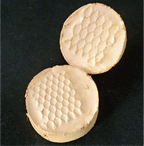Article contents
Novel superflexible resorcinol–formaldehyde aerogels and combining of them with aramid honeycombs
Published online by Cambridge University Press: 11 November 2014
Abstract

We report a new insulation composite of aramid honeycombs filled with superflexible resorcinol–formaldehyde aerogels. Aerogels produced via a sol–gel process were dried with supercritical CO2. The aerogels exhibit a high, rubber-like flexibility, due to almost zero shrinkage and networking of nanoparticles and suitably sized macropores. The high porosity of the aerogels in the range of about 95–98% leads to a low thermal conductivity about 0.037 W/mK and low bulk density of 0.05 g/cm3. The filling of light and stiff aramid honeycombs with these flexible aerogels results in a composite with decreased thermal conductivity and modified mechanical properties.
- Type
- Research Letters
- Information
- Copyright
- Copyright © Materials Research Society 2014
References
- 8
- Cited by




